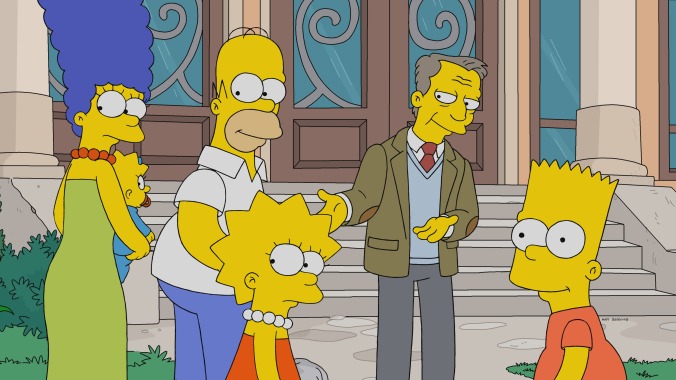Werner Herzog torturing The Simpsons should be funnier than this


“The gas is never a good sign.”
Legendary German filmmaker Werner Herzog has made a slyly lucrative career out of putting us all on. Apart from his hilariously self-parodying turn as Werner Herzog—world-famous documentarian and smug , faux-profound cultural appropriator—in the equally faux-doc Incident At Loch Ness, the outwardly dour Herzog has made a hobby of popping up in American (and other) pop culture as a sonorously menacing, deadpan villain (and/or voyeuristic weirdo and former doll museum curator) on everything from The Manadlorian, to The Grand, to Julien Donkey-Boy, to Jack Reacher, to inimitable animated voiceover work in the likes of Rick And Morty, Metalocalypse, American Dad!, and even The Penguins Of Madagascar, for crying out loud. When his secretly but unsurprisingly evil rehab guru Dr. Lund in tonight’s Simpsons, “Screenless,” reveals that his screen addiction clinic is merely one of his “side hustles,” the man knows of what he speaks in a hypnotically lilting purr.
Part of the appeal is always that such an acclaimed and serious filmmaker would stoop to make dick jokes and act opposite a Baby Yoda, especially since the preternaturally unperturbable Herzog always claims blank-faced ignorance of the particular slice of pop culture he’s appearing in in order to fund his latest film project. Still, the German auteur is clearly tickled by the game he’s playing, and the juxtaposition is one of the main things “Screenless” has going for it. As the seemingly benign Lund (Herzog’s second such quack in as many Simpsons seasons), Herzog essays the role of a beneficent head of a Silicon Valley-funded free clinic to cure the Simpsons and other smart phone junkies of their isolating and imagination-robbing screen addictions. Hustled into the idyllic Messages rehab facility by Marge (revealed to be far more reliant on her devices than anyone), the family undergoes group therapy, zen gardening, and screen-free interaction with their fellow tech slaves, before finding out that anything secretly funded by Silicon Valley billionaires is inevitably, irretrievably evil. (Lund’s running a low-rent password-stealing spam scam with their online info.)
Alas, there’s not enough else to recommend “Screenless,” as the Simpsons’ individual journeys through the hell of online withdrawal are short-changed and unsatisfying. Homer gets good at newspaper jumbles, which has one truncated but lovely little montage sequence where the glimpse of Homer J. Simpson recognizing some hidden talent inside himself is set to evocative music. (He gets so good that he starts solving jumbled words—like “quip” and “jinx”—he otherwise doesn’t know.) Lisa briefly rediscovers the musty, dusty, opossum-infested joys of the library’s neglected card catalog. Bart, like Homer, has the merest hint of a personal arc when he alone among his phone-tapping peers spies a forgotten toy rocket on the school roof and, retrieving it, rediscovers his atrophied imagination. (He even sucks in bullies Dolph and Jimbo to his space narrative.) That Marge sees her well-intentioned mothering boomerang back on her when she herself can’t break free of her need for online recipes (the cookbook Tiffany Haddish’s Fun With Radishes just doesn’t cut it) could be another such character arc, but, like most of the episode’s pre-Messages action, her hidden internet addiction is used merely as preamble to the amusing but overly busy Herzog plot.
See, there are lasers preventing the reawakened (to devices) Simpsons from escaping, and armed guards (Homer foils them by using his newfound jumble skills to change a “garden” sign to “danger” in a genuinely tidy callback), and Maggie’s own newfound sign language skills (oh, Maggie learns sign language along the way) teaches the family how to escape the lasers, and that’s the episode. Maggie stories are tough to pull off at the best of times (no matter what corporate overlords Disney have to say about it), and what looks at first like a significant development for the littlest Simpson (“I used to be America’s baby,” she signs sadly once Marge mentions Baby Yoda) is introduced, dropped, then employed as an adorably disposable deus ex machina in some serious narrative shoe-horning. (Her Bond-esque signed quip “Talc is cheap,” once the family uses her baby powder to dodge those lasers is her best joke in a while.) Also, not to be that guy, but Marge emotionally crowing, “I could finally talk to my baby!,” after seeing the Baby Ein-Sign educational program sort of ignores one of the few Simpsons episodes (on that very topic) to make satisfying use of Maggie. Again, not to be that guy, but, c’mon.
The Simpsons is (and, yes, remains) a miraculous creation, a startlingly realized jumble of high and low laughs, character and wacky plot, satire and silliness. There are plots far more convoluted than “the Simpsons go to an evil rehab to get over their screen addiction” that are among the best half-hours of TV ever produced. (“Homer has to stop the runaway monorail a musical huckster foisted on Springfield.” See?) It’s all a question of balance. In “Screenless,” character is shortchanged, satire is bland and glib, and a very funny guest star still manages to overstay his welcome by the end.
Stray observations
- For an episode that ditches the opening credits almost entirely, “Screenless” yet squanders time at the beginning and end on extended gags that do nothing but subtract from time that could be spent developing the narrative. Netflix does, indeed, make a lot of true crime shows—maybe do an episode on that. (Oh, wait, they did a pretty good one already.) And while the tag suggesting that Herzog’s Lund could return as some sort of Hannibal Lecter-style evil profiler helping Chief Wiggum is pretty irresistible, there’s no reason its 30 seconds couldn’t be deployed elsewhere.
- Marge, resisting her own(?) no-screens policy on Pinterest grounds, tells Homer, “If people fail at cakes, they need to be told.”
- Lund’s description of Messages’ non-computer activities (“the human equivalent of things that work on rats”) include eating, drinking, fornicating, endless adult hide-and-seek, and listening to Dana Gould’s podcast.
- There’s a visit to Patty and Selma where Maggie futilely signs her description, Koko-style, of her aunts, “Fire monster garbage smell.”
- To be fair, Marge did try 14 of Tiffany Haddish’s radish recipes before giving up.
- Homer’s rousingly suspect speech in defense of the family’s internet needs runs through the ineffective ways families happily ignored each other previously: fiddle music, WWI, the radio, WWII, TV.
- Another time-waster is the funny-named rehab center gags over the end credits. “Downton Rehabby” made me laugh, though.